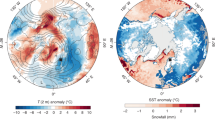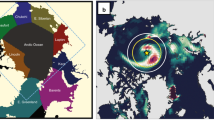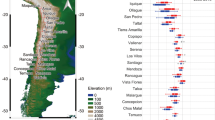Abstract
The decline of the Arctic cryosphere during recent decades has lowered the region’s surface albedo, reducing its ability to reflect solar radiation back to space. It is not clear what role the Antarctic cryosphere plays in this regard, but new remote-sensing-based techniques and datasets have recently opened the possibility to investigate its role. Here, we leverage these to show that the surface albedo reductions from sustained post-2000 losses in Arctic snow and ice cover equate to increasingly positive snow and ice albedo feedback relative to a 1982–1991 baseline period, with a decadal trend of +0.08 ± 0.04 W m–2 decade–1 between 1992 and 2015. During the same period, the expansion of the Antarctic sea-ice pack generated a negative feedback, with a decadal trend of −0.06 ± 0.02 W m–2 decade–1. However, substantial Antarctic sea-ice losses during 2016–2018 completely reversed the trend, increasing the three-year mean combined Arctic and Antarctic snow and ice albedo feedback to +0.26 ± 0.15 W m–2. This reversal highlights the importance of Antarctic sea-ice loss to the global snow and ice albedo feedback. The 1992–2018 mean feedback is equivalent to approximately 10% of anthropogenic CO2 emissions over the same period; the share may rise markedly should 2016–2018 snow and ice conditions become common, although increasing long-wave emissions will probably mediate the impact on the total radiative-energy budget.
This is a preview of subscription content, access via your institution
Access options
Access Nature and 54 other Nature Portfolio journals
Get Nature+, our best-value online-access subscription
$29.99 / 30 days
cancel any time
Subscribe to this journal
Receive 12 print issues and online access
$259.00 per year
only $21.58 per issue
Buy this article
- Purchase on Springer Link
- Instant access to full article PDF
Prices may be subject to local taxes which are calculated during checkout




Similar content being viewed by others
Data availability
The principal result data (annual global radiative forcings per kernel and region) are available from https://doi.org/10.23728/fmi-b2share.fb5a74c32c0b4e49989334f76b370de2. The CLARA-A2.1 albedo data are available from https://doi.org/10.5676/EUM_SAF_CM/CLARA_AVHRR/V002_01. The CC radiative kernel is available from https://climate.rsmas.miami.edu/data/radiative-kernels/index.html. The CACK radiative kernel is available from https://doi.org/10.6073/pasta/d77b84b11be99ed4d5376d77fe0043d8. NSIDC-0046 and G02202 snow/sea-ice data records are available through https://nsidc.org/data. ESA-CCI LC data are available from the ESA Climate Change Initiative through http://maps.elie.ucl.ac.be/CCI/viewer/download.php. The CERES EBAF Edition 4.1 dataset is available through https://asdc.larc.nasa.gov/project/CERES/CERES_EBAF_Edition4.1. Source data are provided with this paper.
Code availability
Principal data analysis codes are available from https://doi.org/10.23728/fmi-b2share.fb5a74c32c0b4e49989334f76b370de2.
References
Sledd, A. & L’Ecuyer, T. How much do clouds mask the impacts of Arctic sea ice and snow cover variations? Different perspectives from observations and reanalyses. Atmosphere 10, 12 (2019).
Flanner, M. G., Shell, K. M., Barlage, M., Perovich, D. K. & Tschudi, M. A. Radiative forcing and albedo feedback from the Northern Hemisphere cryosphere between 1979 and 2008. Nat. Geosci. 4, 151–155 (2011).
Loeb, N., Thorsen, T., Norris, J., Wang, H. & Su, W. Changes in Earth’s energy budget during and after the ‘pause’ in global warming: an observational perspective. Climate 6, 62 (2018).
Chung, E.-S. & Soden, B. J. An assessment of methods for computing radiative forcing in climate models. Environ. Res. Lett. 10, 074004 (2015).
Dong, X. et al. A 10 year climatology of Arctic cloud fraction and radiative forcing at Barrow, Alaska. J. Geophys. Res. Atmos. 115, D17212 (2010).
Zhang, R., Wang, H., Fu, Q., Rasch, P. J. & Wang, X. Unraveling driving forces explaining significant reduction in satellite-inferred Arctic surface albedo since the 1980s. Proc. Natl Acad. Sci. USA 116, 23947–23953 (2019).
Karlsson, K. G. et al. CLARA-A2: the second edition of the CM SAF cloud and radiation data record from 34 years of global AVHRR data. Atmos. Chem. Phys. 17, 5809–5828 (2017).
Anttila, K., Jääskeläinen, E., Riihelä, A., Manninen, T. & Andersson, K. Validation Report for Surface Albedo (SAL) in the CLARA-A2 CM SAF Cloud, Albedo, Radiation Data Record, AVHRR-Based Edition 2, https://www.cmsaf.eu (EUMETSAT CM SAF, 2016).
Riihelä, A., King, M. D. & Anttila, K. The surface albedo of the Greenland Ice Sheet between 1982 and 2015 from the CLARA-A2 dataset and its relationship to the ice sheet’s surface mass balance. Cryosphere 13, 2597–2614 (2019).
Kramer, R. J., Matus, A. V., Soden, B. J. & L’Ecuyer, T. S. Observation‐based radiative kernels from CloudSat/CALIPSO. J. Geophys. Res. Atmos. 124, 5431–5444 (2019).
Bright, R. M. & O’Halloran, T. L. Developing a monthly radiative kernel for surface albedo change from satellite climatologies of Earth’s shortwave radiation budget: CACK v1.0. Geosci. Model Dev. 12, 3975–3990 (2019).
Loeb, N. G. et al. Clouds and the Earth’s Radiant Energy System (CERES) Energy Balanced and Filled (EBAF) top-of-atmosphere (TOA) edition-4.0 data product. J. Clim. 31, 895–918 (2018).
Betts, R. A. Offset of the potential carbon sink from boreal forestation by decreases in surface albedo. Nature 408, 187–190 (2000).
Kwok, R. Arctic sea ice thickness, volume, and multiyear ice coverage: losses and coupled variability (1958–2018). Environ. Res. Lett. 13, 105005 (2018).
Wang, L., Derksen, C., Brown, R. & Markus, T. Recent changes in pan‐Arctic melt onset from satellite passive microwave measurements. Geophys. Res. Lett. 40, 522–528 (2013).
Anttila, K., Manninen, T., Jääskeläinen, E., Riihelä, A. & Lahtinen, P. The role of climate and land use in the changes in surface albedo prior to snow melt and the timing of melt season of seasonal snow in northern land areas of 40° N–80° N during 1982–2015. Remote Sens. 10, 1619 (2018).
Jeffries, M. O., Richter-Menge, J. A. & Overland, J. E. (eds) Arctic Report Card 2013, http://www.arctic.noaa.gov/reportcard (NOAA, 2013).
Parkinson, C. L. A 40-y record reveals gradual Antarctic sea ice increases followed by decreases at rates far exceeding the rates seen in the Arctic. Proc. Natl Acad. Sci. USA 116, 14414–14423 (2019).
Letterly, A., Key, J. & Liu, Y. Arctic climate: changes in sea ice extent outweigh changes in snow cover. Cryosphere 12, 3373–3382 (2018).
Turner, J. et al. Unprecedented springtime retreat of Antarctic sea ice in 2016. Geophys. Res. Lett. 44, 6868–6875 (2017).
Wang, G. et al. Compounding tropical and stratospheric forcing of the record low Antarctic sea-ice in 2016. Nat. Commun. 10, 13 (2019).
Meehl, G. A. et al. Sustained ocean changes contributed to sudden Antarctic sea ice retreat in late 2016. Nat. Commun. 10, 14 (2019).
Fetterer, F., Knowles, K., Meier, W. N., Savoie, M. & Windnagel, A. K. Sea Ice Index Version 3, https://doi.org/10.7265/N5K072F8 (NSIDC, accessed 1 October 2020).
Meier, W. N. et al. NOAA/NSIDC Climate Data Record of Passive Microwave Sea Ice Concentration Version 3, https://doi.org/10.7265/N59P2ZTG (NSIDC, accessed 1 October 2020).
Kern, S., Lavergne, T., Notz, D., Pedersen, L. T. & Tonboe, R. Satellite passive microwave sea-ice concentration data set inter-comparison for Arctic summer conditions. Cryosphere 14, 2469–2493 (2020).
Pistone, K., Eisenman, I. & Ramanathan, V. Radiative heating of an ice‐free Arctic Ocean. Geophys. Res. Lett. 46, 7474–7480 (2019).
Schlosser, E., Haumann, F. A. & Raphael, M. N. Atmospheric influences on the anomalous 2016 Antarctic sea ice decay. Cryosphere 12, 1103–1119 (2018).
Wang, Z., Turner, J., Wu, Y. & Liu, C. Rapid decline of total Antarctic sea ice extent during 2014–16 controlled by wind-driven sea ice drift. J. Clim. 32, 5381–5395 (2019).
Kashiwase, H., Ohshima, K. I., Nihashi, S. & Eicken, H. Evidence for ice–ocean albedo feedback in the Arctic Ocean shifting to a seasonal ice zone. Sci. Rep. 7, 8170 (2017).
Eayrs, C., Li, X., Raphael, M. N. & Holland, D. M. Rapid decline in Antarctic sea ice in recent years hints at future change. Nat. Geosci. 14, 460–464 (2021).
Jones, J. et al. Assessing recent trends in high-latitude Southern Hemisphere surface climate. Nat. Clim. Change 6, 917–926 (2016).
Roach, L. A. et al. Antarctic sea ice area in CMIP6. Geophys. Res. Lett. 47, e2019GL086729 (2020).
Chemke, R. & Polvani, L. M. Using multiple large ensembles to elucidate the discrepancy between the 1979–2019 modeled and observed Antarctic sea ice trends. Geophys. Res. Lett. 47, e2020GL088339 (2020).
Gelaro, R. et al. The Modern-Era Retrospective Analysis for Research and Applications, version 2 (MERRA-2). J. Clim. 30, 5419–5454 (2017).
Hersbach, H. et al. The ERA5 global reanalysis. Q. J. R. Meteorol. Soc. 146, 1999–2049 (2020).
Donohoe, A., Blanchard-Wrigglesworth, E., Schweiger, A. & Rasch, P. J. The effect of atmospheric transmissivity on model and observational estimates of the sea ice albedo feedback. J. Clim. 33, 5743–5765 (2020).
Hall, A. The role of surface albedo feedback in climate. J. Clim. 17, 1550–1568 (2004).
Platnick, S. et al. The MODIS cloud products: algorithms and examples from Terra. IEEE Trans. Geosci. Remote Sens. 41, 459–473 (2003).
Kay, J. E. & Gettelman, A. Cloud influence on and response to seasonal Arctic sea ice loss. J. Geophys. Res. Atmos. 114 (2009).
Tomasi, C. et al. An update on polar aerosol optical properties using POLAR-AOD and other measurements performed during the International Polar Year. Atmos. Environ. 52, 29–47 (2012).
Donohoe, A. & Battisti, D. S. Atmospheric and surface contributions to planetary albedo. J. Clim. 24, 4402–4418 (2011).
Heidinger, A. K., Straka, W. C., Molling, C. C., Sullivan, J. T. & Wu, X. Q. Deriving an inter-sensor consistent calibration for the AVHRR solar reflectance data record. Int. J. Remote Sens. 31, 6493–6517 (2010).
Jääskeläinen, E., Manninen, T., Tamminen, J. & Laine, M. The Aerosol Index and Land Cover Class Based Atmospheric Correction Aerosol Optical Depth Time Series 1982–2014 for the SMAC algorithm. Remote Sens. 9, 1095 (2017).
Manninen, T., Jääskeläinen, E. & Riihelä, A. Black and white-sky albedo values of snow: in situ relationships for AVHRR-based estimation using CLARA-A2 SAL. Can. J. Remote Sens. 45, 350–367 (2019).
Brodzik, M. J. & Armstrong, R. Northern Hemisphere EASE-Grid 2.0 Weekly Snow Cover and Sea Ice Extent Version 4, https://doi.org/10.5067/P7O0HGJLYUQU (NSIDC, accessed 1 August 2020).
Séférian, R. et al. An interactive ocean surface albedo scheme (OSAv1. 0): formulation and evaluation in ARPEGE-Climat (V6. 1) and LMDZ (V5A). Geosci. Model Dev. 11, 321–338 (2018).
Schaaf, C. B. et al. First operational BRDF, albedo nadir reflectance products from MODIS. Remote Sens. Environ. 83, 135–148 (2002).
Acknowledgements
Work of A.R. has been financially supported by the Academy of Finland, decision 309125, and R.M.B. through the Research Council of Norway, project number 294948 (EMERALD). Natural Earth map dataset is acknowledged as the coastline data source in spatially resolved figures.
Author information
Authors and Affiliations
Contributions
A.R. designed the study and performed the SIAF calculations. R.M.B. contributed CACK data with updated uncertainty estimates, analysed CACK–CC differences and carried out the CERES EBAF analysis. K.A. supported the SIAF analysis and analysed potential aerosol impacts. A.R., R.M.B. and K.A. all contributed to the writing of the manuscript.
Corresponding author
Ethics declarations
Competing interests
The authors declare no competing interests.
Additional information
Peer review information Nature Geoscience thanks Aaron Donohoe, Chad Thackeray and the other, anonymous, reviewer(s) for their contribution to the peer review of this work. Primary Handling Editor: Thomas Richardson, in collaboration with the Nature Geoscience team.
Publisher’s note Springer Nature remains neutral with regard to jurisdictional claims in published maps and institutional affiliations.
Supplementary information
Supplementary Information
Supplementary Figs. 1–10, descriptions and text.
Source data
Source Data Fig. 1
Source data for line plots and uncertainty envelopes.
Source Data Fig. 2
Source data for bar charts in figure.
Rights and permissions
About this article
Cite this article
Riihelä, A., Bright, R.M. & Anttila, K. Recent strengthening of snow and ice albedo feedback driven by Antarctic sea-ice loss. Nat. Geosci. 14, 832–836 (2021). https://doi.org/10.1038/s41561-021-00841-x
Received:
Accepted:
Published:
Issue Date:
DOI: https://doi.org/10.1038/s41561-021-00841-x
This article is cited by
-
Warmer Antarctic summers in recent decades linked to earlier stratospheric final warming occurrences
Communications Earth & Environment (2024)
-
Unraveling the optical shape of snow
Nature Communications (2023)
-
Warm surface waters increase Antarctic ice shelf melt and delay dense water formation
Communications Earth & Environment (2022)



